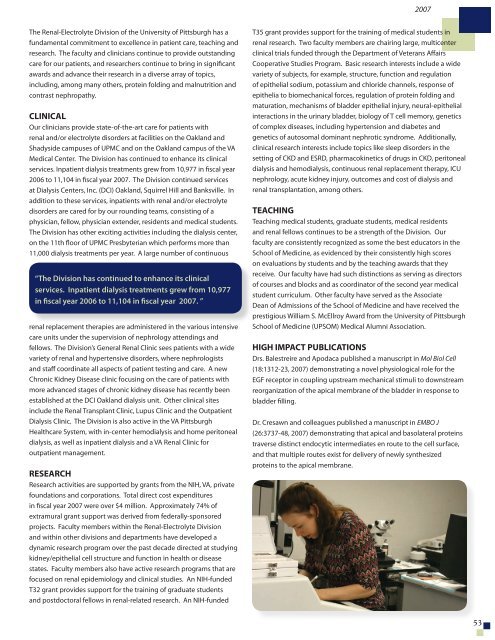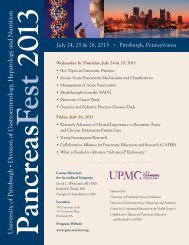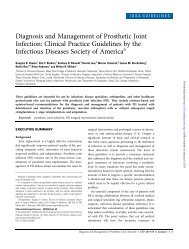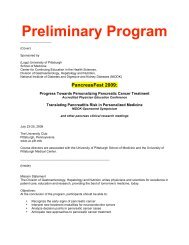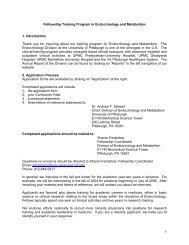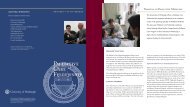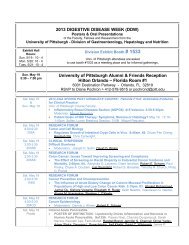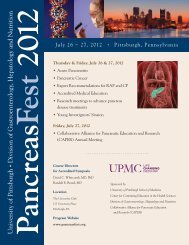2009 DOM Annual Report - Department of Medicine - University of ...
2009 DOM Annual Report - Department of Medicine - University of ...
2009 DOM Annual Report - Department of Medicine - University of ...
- No tags were found...
You also want an ePaper? Increase the reach of your titles
YUMPU automatically turns print PDFs into web optimized ePapers that Google loves.
2007The Renal-Electrolyte Division <strong>of</strong> the <strong>University</strong> <strong>of</strong> Pittsburgh has afundamental commitment to excellence in patient care, teaching andresearch. The faculty and clinicians continue to provide outstandingcare for our patients, and researchers continue to bring in significantawards and advance their research in a diverse array <strong>of</strong> topics,including, among many others, protein folding and malnutrition andcontrast nephropathy.CLINICALOur clinicians provide state-<strong>of</strong>-the-art care for patients withrenal and/or electrolyte disorders at facilities on the Oakland andShadyside campuses <strong>of</strong> UPMC and on the Oakland campus <strong>of</strong> the VAMedical Center. The Division has continued to enhance its clinicalservices. Inpatient dialysis treatments grew from 10,977 in fiscal year2006 to 11,104 in fiscal year 2007. The Division continued servicesat Dialysis Centers, Inc. (DCI) Oakland, Squirrel Hill and Banksville. Inaddition to these services, inpatients with renal and/or electrolytedisorders are cared for by our rounding teams, consisting <strong>of</strong> aphysician, fellow, physician extender, residents and medical students.The Division has other exciting activities including the dialysis center,on the 11th floor <strong>of</strong> UPMC Presbyterian which performs more than11,000 dialysis treatments per year. A large number <strong>of</strong> continuous“The Division has continued to enhance its clinicalservices. Inpatient dialysis treatments grew from 10,977in fiscal year 2006 to 11,104 in fiscal year 2007. ”renal replacement therapies are administered in the various intensivecare units under the supervision <strong>of</strong> nephrology attendings andfellows. The Division’s General Renal Clinic sees patients with a widevariety <strong>of</strong> renal and hypertensive disorders, where nephrologistsand staff coordinate all aspects <strong>of</strong> patient testing and care. A newChronic Kidney Disease clinic focusing on the care <strong>of</strong> patients withmore advanced stages <strong>of</strong> chronic kidney disease has recently beenestablished at the DCI Oakland dialysis unit. Other clinical sitesinclude the Renal Transplant Clinic, Lupus Clinic and the OutpatientDialysis Clinic. The Division is also active in the VA PittsburghHealthcare System, with in-center hemodialysis and home peritonealdialysis, as well as inpatient dialysis and a VA Renal Clinic foroutpatient management.RESEARCHResearch activities are supported by grants from the NIH, VA, privatefoundations and corporations. Total direct cost expendituresin fiscal year 2007 were over $4 million. Approximately 74% <strong>of</strong>extramural grant support was derived from federally-sponsoredprojects. Faculty members within the Renal-Electrolyte Divisionand within other divisions and departments have developed adynamic research program over the past decade directed at studyingkidney/epithelial cell structure and function in health or diseasestates. Faculty members also have active research programs that arefocused on renal epidemiology and clinical studies. An NIH-fundedT32 grant provides support for the training <strong>of</strong> graduate studentsand postdoctoral fellows in renal-related research. An NIH-fundedT35 grant provides support for the training <strong>of</strong> medical students inrenal research. Two faculty members are chairing large, multicenterclinical trials funded through the <strong>Department</strong> <strong>of</strong> Veterans AffairsCooperative Studies Program. Basic research interests include a widevariety <strong>of</strong> subjects, for example, structure, function and regulation<strong>of</strong> epithelial sodium, potassium and chloride channels, response <strong>of</strong>epithelia to biomechanical forces, regulation <strong>of</strong> protein folding andmaturation, mechanisms <strong>of</strong> bladder epithelial injury, neural-epithelialinteractions in the urinary bladder, biology <strong>of</strong> T cell memory, genetics<strong>of</strong> complex diseases, including hypertension and diabetes andgenetics <strong>of</strong> autosomal dominant nephrotic syndrome. Additionally,clinical research interests include topics like sleep disorders in thesetting <strong>of</strong> CKD and ESRD, pharmacokinetics <strong>of</strong> drugs in CKD, peritonealdialysis and hemodialysis, continuous renal replacement therapy, ICUnephrology, acute kidney injury, outcomes and cost <strong>of</strong> dialysis andrenal transplantation, among others.TEACHINGTeaching medical students, graduate students, medical residentsand renal fellows continues to be a strength <strong>of</strong> the Division. Ourfaculty are consistently recognized as some the best educators in theSchool <strong>of</strong> <strong>Medicine</strong>, as evidenced by their consistently high scoreson evaluations by students and by the teaching awards that theyreceive. Our faculty have had such distinctions as serving as directors<strong>of</strong> courses and blocks and as coordinator <strong>of</strong> the second year medicalstudent curriculum. Other faculty have served as the AssociateDean <strong>of</strong> Admissions <strong>of</strong> the School <strong>of</strong> <strong>Medicine</strong> and have received theprestigious William S. McEllroy Award from the <strong>University</strong> <strong>of</strong> PittsburghSchool <strong>of</strong> <strong>Medicine</strong> (UPSOM) Medical Alumni Association.HIGH IMPACT PUBLICATIONSDrs. Balestreire and Apodaca published a manuscript in Mol Biol Cell(18:1312-23, 2007) demonstrating a novel physiological role for theEGF receptor in coupling upstream mechanical stimuli to downstreamreorganization <strong>of</strong> the apical membrane <strong>of</strong> the bladder in response tobladder filling.Dr. Cresawn and colleagues published a manuscript in EMBO J(26:3737-48, 2007) demonstrating that apical and basolateral proteinstraverse distinct endocytic intermediates en route to the cell surface,and that multiple routes exist for delivery <strong>of</strong> newly synthesizedproteins to the apical membrane.53


